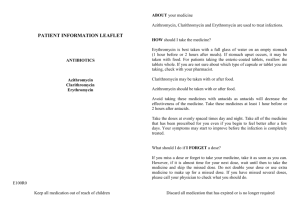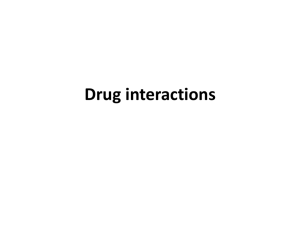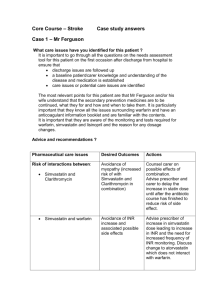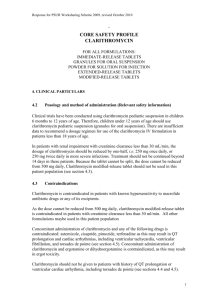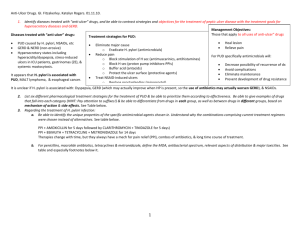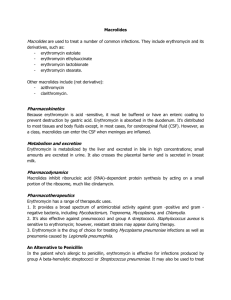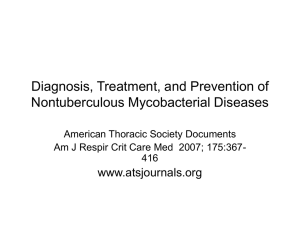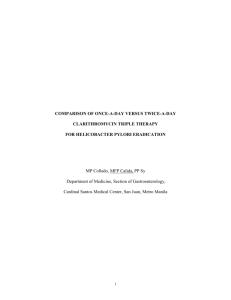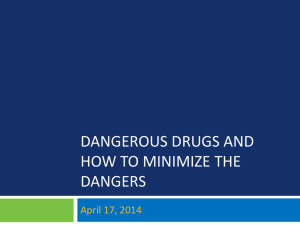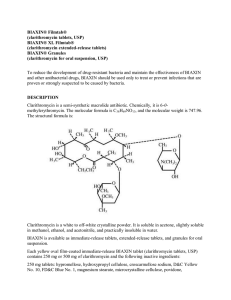הודעה על החמרה ( מידע בטיחות) בעלון לצרכן
advertisement
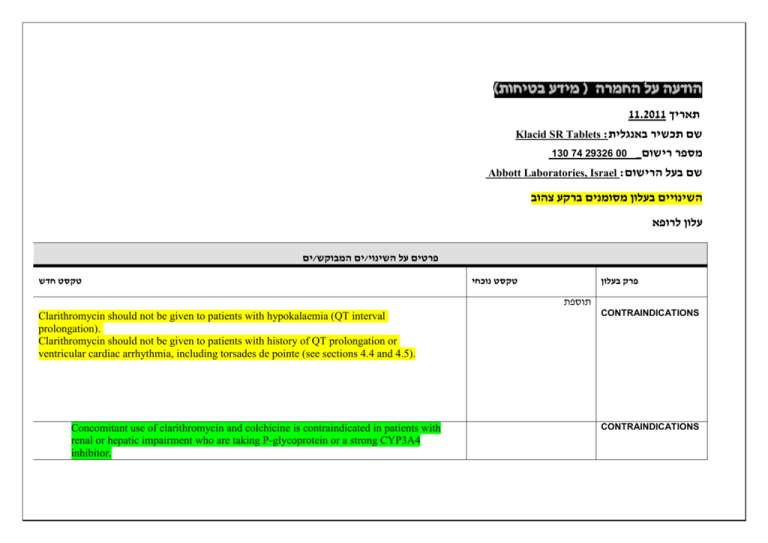
)בטיחות )מידע בטיחות החמרה (( מידע על החמרה הודעה על הודעה 11.2011 תאריך Klacid SR Tablets :שם תכשיר באנגלית 130 74 29326 00 _מספר רישום Abbott Laboratories, Israel :שם בעל הרישום השינויים בעלון מסומנים ברקע צהוב עלון לרופא ים/ים המבוקש/פרטים על השינוי טקסט חדש טקסט נוכחי פרק בעלון תוספת Clarithromycin should not be given to patients with hypokalaemia (QT interval prolongation). Clarithromycin should not be given to patients with history of QT prolongation or ventricular cardiac arrhythmia, including torsades de pointe (see sections 4.4 and 4.5). Concomitant use of clarithromycin and colchicine is contraindicated in patients with renal or hepatic impairment who are taking P-glycoprotein or a strong CYP3A4 inhibitor. CONTRAINDICATIONS CONTRAINDICATIONS תוספת Cases of fatal hepatic failure (see section 4.8) have been reported. Some patients may have had pre-existing hepatic disease or may have been taking other hepatotoxic medicinal products. Patients should be advised to stop treatment and contact their doctor if signs and symptoms of hepatic disease develop, such as anorexia, jaundice, dark urine, pruritus, or tender abdomen. Pseudomembranous colitis has been reported with nearly all antibacterial agents,including clarithromycin, and may range in severity from mild to life threatening. Warnings And Precautions Clostridium difficile associated diarrhoea (CDAD) has been reported with use of nearly all antibacterial agents including clarithromycin, and may range in severity from mild diarrhoea to fatal colitis. Treatment with antibacterial agents alters the normal flora of the colon, which may lead to overgrowth of C. difficile. CDAD must be considered in all patients who present with diarrhoea following antibiotic use. Careful medical history is necessary since CDAD has been reported to occur over two months after the administration of antibacterial agents. Therefore, discontinuation of clarithromycin therapy should be considered regardless of the indication. Microbial testing should be performed and adequate treatment initiated. Drugs inhibiting peristalsis should be avoided. Exacerbation of symptoms of myasthenia gravis has been reported in patients receiving clarithromycin therapy. Caution is advised regarding concomitant administration of clarithromycin with other ototoxic drugs, especially with aminoglycosides. Monitoring of vestibular and auditory function should be carried out during and after treatment. Warnings And Precautions Due to the risk for QT prolongation, clarithromycin should be used with caution in patients with coronary artery disease, severe cardiac insufficiency, hypomagnesemia, bradycardia (<50 bpm), or when co-administered with other medicinal products associated with QT prolongation (see section 4.5). Clarithromycin should not be used in patients with congenital or documented acquired QT prolongation or history of ventricular arrhythmia (see section 4.3). Pneumonia: In view of the emerging resistance of Streptococcus pneumoniae to macrolides, it is important that sensitivity testing be performed when prescribing clarithromycin for community-acquired pneumonia. In hospital-acquired pneumonia, clarithromycin should be used in combination with additional appropriate antibiotics. Skin and soft tissue infections of mild to moderate severity: These infections are most often caused by Staphylococcus aureus and Streptococcus pyogenes, both of which may be resistant to macrolides. Therefore, it is important that sensitivity testing be performed. In cases where beta–lactam antibiotics cannot be used (e.g. allergy), other antibiotics, such as clindamycin, may be the drug of first choice. Currently, macrolides are only considered to play a role in some skin and soft tissue infections, such as those caused by Corynebacterium minutissimum (erythrasma), acne vulgaris, and erysipelas and in situations where penicillin treatment cannot be used. In the event of severe acute hypersensitivity reactions, such as anaphylaxis, StevensJohnson Syndrome, toxic epidermal necrolysis, , DRESS and Henoch Schonlein Purpura clarithromycin therapy should be discontinued immediately and appropriate treatment should be urgently initiated. HMG-CoA reductase inhibitors: Concomitant use of clarithromycin with lovastatin or simvastatin is contraindicated (see section 4.3). As with other macrolides, clarithromycin has been reported to increase concentrations of HMG-CoA reductase inhibitors (see section 4.5). Rare reports of rhabdomyolysis have been reported in patients taking these drugs concomitantly. Patients should be monitored for signs and symptoms of myopathy. Rare reports of rhabdomyolysis have also been reported in patients taking atorvastatin or rosuvastatin concomitantly with clarithromycin. When used with clarithromycin, atorvastatin or rosuvastatin should be administered in the lowest possible doses. Adjustment of the statin dose or use of a statin that is not dependent on CYP3A metabolism (e.g. fluvastatin or pravastatin) should be considered. Oral hypoglycemic agents/Insulin: The concomitant use of clarithromycin and oral hypoglycemic agents and/or insulin can result in significant hypoglycemia. With certain hypoglycemic drugs such as nateglinide, pioglitazone, repaglinide and rosiglitazone, inhibition of CYP3A enzyme by clarithromycin may be involved and could cause hypolgycemia when used concomitantly. Careful monitoring of glucose is recommended. Fluconazole Concomitant administration of fluconazole 200 mg daily and clarithromycin 500 mg twice daily to 21 healthy volunteers led to increases in the mean steady-state minimum clarithromycin concentration (Cmin) and area under the curve (AUC) of 33% and 18% respectively. Steady state concentrations of the active metabolite 14(R)- hydroxyclarithromycin were not significantly affected by concomitant administration of fluconazole. No clarithromycin dose adjustment is necessary. Etravirine Clarithromycin exposure was decreased by etravirine; however, concentrations of the active metabolite, 14-OH-clarithromycin, were increased. Because 14-OH-clarithromycin has reduced activity against Mycobacterium avium complex (MAC), overall activity against this pathogen may be altered; therefore alternatives to clarithromycin should be considered for the treatment of MAC. מסומנות.כל הפרק השתנה אינטראקציות שכלל לא הופיעו בעלון המאושר ואת שאר הפרק .אנו מבקשים לקבל כמות שהוא Drug Interactions Omeprazole Clarithromycin (500 mg every 8 hours) was given in combination with omeprazole (40 mg daily) to healthy adult subjects. The steady-state plasma concentrations of omeprazole were increased (Cmax, AUC0-24, and t1/2 increased by 30%, 89%, and 34%, respectively), by the concomitant administration of clarithromycin. The mean 24-hour gastric pH value was 5.2 when omeprazole was administered alone and 5.7 when omeprazole was coadministered with clarithromycin. Tolterodine The primary route of metabolism for tolterodine is via the 2D6 isoform of cytochrome P450 (CYP2D6). However, in a subset of the population devoid of CYP2D6, the identified pathway of metabolism is via CYP3A. In this population subset, inhibition of CYP3A results in significantly higher serum concentrations of tolterodine. A reduction in tolterodine dosage may be necessary in the presence of CYP3A inhibitors, such as clarithromycin in the CYP2D6 poor metabolizer population. Atazanavir Both clarithromycin and atazanavir are substrates and inhibitors of CYP3A, and there is evidence of a bi-directional drug interaction. Co-administration of clarithromycin (500 mg twice daily) with atazanavir (400 mg once daily) resulted in a 2-fold increase in exposure to clarithromycin and a 70% decrease in exposure to 14(R)-hydroxyclarithromycin, with a 28% increase in the AUC of atazanavir. Because of the large therapeutic window for clarithromycin, no dosage reduction should be necessary in patients with normal renal function. For patients with moderate renal function (creatinine clearance 30 to 60 ml/min), the dose of clarithromycin should be decreased by 50%. For patients with creatinine clearance <30 ml/min, the dose of clarithromycin should be decreased by 75% using an appropriate clarithromycin formulation, Doses of clarithromycin greater than 1000 mg per day should not be coadministered with protease inhibitors. Itraconazole Both clarithromycin and itraconazole are substrates and inhibitors of CYP3A, leading to a bidirectional drug interaction: Clarithromycin may increase the plasma levels of itraconazole, while itraconazole may increase the plasma levels of clarithromycin. Patients taking itraconazole and clarithromycin concomitantly should be monitored closely for signs or symptoms of increased or prolonged pharmacologic effect. Saquinavir Both clarithromycin and saquinavir are substrates and inhibitors of CYP3A, and there is evidence of a bidirectional drug interaction. Concomitant administration of clarithromycin (500 mg twice daily) and saquinavir (soft gelatin capsules, 1200 mg three times daily) to 12 healthy volunteers resulted in steady-state area under the curve (AUC) and maximum concentration (Cmax) values of saquinavir which were 177% and 187% higher than those seen with saquinavir alone. Clarithromycin AUC and Cmax values were approximately 40% higher than those seen with clarithromycin alone. No dose adjustment is required when the two drugs are co-administered for a limited time at the doses/formulations studied. Observations from drug interaction studies using the soft gelatin capsule formulation may not be representative of the effects seen using the saquinavir hard gelatin capsule. Observations from drug interaction studies done with unboosted saquinavir may not be representative of the effects seen with saquinavir/ritonavir therapy. When saquinavir is co-administered with ritonavir, consideration should be given to the potential effects of ritonavir on clarithromycin (see section above, effect of other medicinal products on clarithromycin). Verapamil Hypotension, bradyarrhythmias and lactic acidosis have been observed in patients taking clarithromycin and verapamil concomitantly. Anorexia, decreased Appetite, Epistaxis gastrooesophageal reflux disease, gastritis, proctalgia constipation, dry mouth, eructation, flatulence, Agranulocytosis Deafness Hemorrhage jaundice hepatocellular acne myopathy International normalised ratioincreased prothrombin time prolonged, urine color abnormal נתונים לא.כל הפרק השתנה הוצגו בטבלה ולפי שכיחות ולא ניתן להשוות לעלון המעודכן ”אחד הלוואי שכלל. מסומנות ת."לאחד לא הופיעו בעלון המאושר עבור צורת המתן הנוכחית ואת שאר הפרק אנו מבקשים לקבל כמות .שהוא ADVERSE REACTIONS
